
Rabbit Anti-MCT1 antibody
monocarboxylate transporter 1; Malignant T cell amplified sequence 1; MCT 1; MCT1; MCTS 1; MCTS1; Oncogene MCT 1; Oncogene MCT1; SLC16A1; FLJ36745; HHF7; MCT; MGC44475; monocarboxylate transporter; Monocarboxylate transporter isoform 1; Monocarboxylic aci
View History [Clear]
Details
Product Name MCT1 Chinese Name 单羧酸Transporter-1抗体 Alias monocarboxylate transporter 1; Malignant T cell amplified sequence 1; MCT 1; MCT1; MCTS 1; MCTS1; Oncogene MCT 1; Oncogene MCT1; SLC16A1; FLJ36745; HHF7; MCT; MGC44475; monocarboxylate transporter; Monocarboxylate transporter isoform 1; Monocarboxylic acid transporter 1; SLC16A1; SLC16A1 protein; Solute carrier family 16 (monocarboxylic acid transporters) member 1; Solute carrier family 16 member 1 (monocarboxylic acid transporter 1); Solute carrier family 16 member 1; MOT1_HUMAN. literatures Research Area immunology Transporter Exchange protein Immunogen Species Rabbit Clonality Polyclonal React Species Human, Mouse, Rat, (predicted: Dog, Pig, Cow, Horse, Rabbit, Guinea Pig, ) Applications WB=1:500-2000 ELISA=1:5000-10000 IHC-P=1:100-500 IHC-F=1:100-500 Flow-Cyt=1μg/Test IF=1:100-500 (Paraffin sections need antigen repair)
not yet tested in other applications.
optimal dilutions/concentrations should be determined by the end user.Theoretical molecular weight 55kDa Cellular localization The cell membrane Form Liquid Concentration 1mg/ml immunogen KLH conjugated synthetic peptide derived from human MCT1: 251-350/500 <Extracellular> Lsotype IgG Purification affinity purified by Protein A Buffer Solution 0.01M TBS(pH7.4) with 1% BSA, 0.03% Proclin300 and 50% Glycerol. Storage Shipped at 4℃. Store at -20 °C for one year. Avoid repeated freeze/thaw cycles. Attention This product as supplied is intended for research use only, not for use in human, therapeutic or diagnostic applications. PubMed PubMed Product Detail The protein encoded by this gene is a proton-linked monocarboxylate transporter that catalyzes the movement of many monocarboxylates, such as lactate and pyruvate, across the plasma membrane. Mutations in this gene are associated with erythrocyte lactate transporter defect. Alternatively spliced transcript variants have been found for this gene.[provided by RefSeq, Oct 2009]
Function:
Proton-linked monocarboxylate transporter. Catalyzes the rapid transport across the plasma membrane of many monocarboxylates such as lactate, pyruvate, branched-chain oxo acids derived from leucine, valine and isoleucine, and the ketone bodies acetoacetate, beta-hydroxybutyrate and acetate.
Subcellular Location:
Cell membrane; Multi-pass membrane protein.
Tissue Specificity:
Widely expressed in normal and in cancer cells.
DISEASE:
Defects in SLC16A1 are the cause of symptomatic deficiency in lactate transport (SDLT) [MIM:245340]; also known as erythrocyte lactate transporter defect. Deficiency of lactate transporter may result in an acidic intracellular environment created by muscle activity with consequent degeneration of muscle and release of myoglobin and creatine kinase. This defect might compromise extreme performance in otherwise healthy individuals.
Defects in SLC16A1 are the cause of familial hyperinsulinemic hypoglycemia type 7 (HHF7) [MIM:610021]; also known as exercise-induced hyperinsulinemic hypoglycemia. HHF7 is a dominantly inherited hypoglycemic disorder characterized by inappropriate insulin secretion during anaerobic exercise or on pyruvate load.
Similarity:
Belongs to the major facilitator superfamily. Monocarboxylate porter (TC 2.A.1.13) family.
SWISS:
P53985
Gene ID:
6566
Database links:Entrez Gene: 6566 Human
Entrez Gene: 20501 Mouse
Omim: 600682 Human
SwissProt: P53985 Human
SwissProt: P53986 Mouse
Unigene: 75231 Human
Unigene: 9086 Mouse
Product Picture
Primary: Anti-MCT1(SL10249R)at 1/300 dilution
Secondary: IRDye800CW Goat Anti-RabbitIgG at 1/20000 dilution
Predicted band size: 55kD
Observed band size: 55kD
Sample:
Lane 1: Liver (Mouse) Lysate at 40 ug
Lane 2: Stomach (Mouse) Lysate at 40 ug
Lane 3: Heart (Mouse) Lysate at 40 ug
Lane 4: Liver (Rat) Lysate at 40 ug
Lane 5: Stomach (Rat) Lysate at 40 ug
Lane 6: Heart (Rat) Lysate at 40 ug
Primary: Anti-MCT1 (SL10249R) at 1/1000 dilution
Secondary: IRDye800CW Goat Anti-Rabbit IgG at 1/20000 dilution
Predicted band size: 48 kD
Observed band size: 48 kD
Paraformaldehyde-fixed, paraffin embedded (rat brain); Antigen retrieval by boiling in sodium citrate buffer (pH6.0) for 15min; Block endogenous peroxidase by 3% hydrogen peroxide for 20 minutes; Blocking buffer (normal goat serum) at 37°C for 30min; Antibody incubation with (MCT1) Polyclonal Antibody, Unconjugated (SL10249R) at 1:400 overnight at 4°C, followed by operating according to SP Kit(Rabbit) (sp-0023) instructionsand DAB staining.Blank control:K562.
Primary Antibody (green line): Rabbit Anti-MCT1 antibody (SL10249R)
Dilution: 1μg /10^6 cells;
Isotype Control Antibody (orange line): Rabbit IgG .
Secondary Antibody : Goat anti-rabbit IgG-FITC
Dilution: 0.5μg /test.
Protocol
The cells were incubated in 5%BSA to block non-specific protein-protein interactions for 30 min at room temperature .Cells stained with Primary Antibody for 30 min at room temperature. The secondary antibody used for 40 min at room temperature. Acquisition of 20,000 events was performed.
Bought notes(bought amounts latest0)
No one bought this product
User Comment(Total0User Comment Num)
- No comment
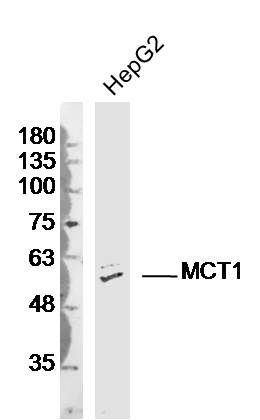
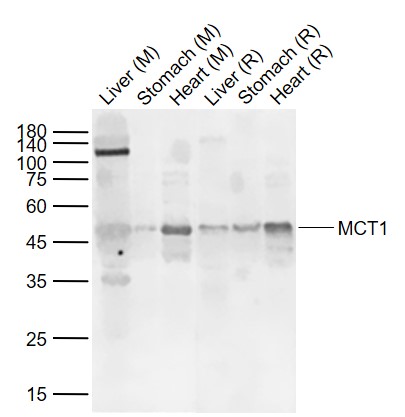
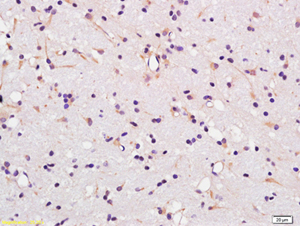
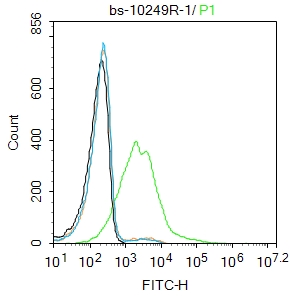
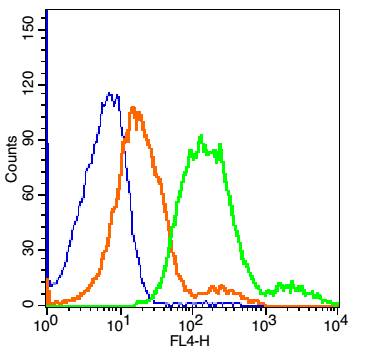


 +86 571 56623320
+86 571 56623320
 +86 18668110335
+86 18668110335

